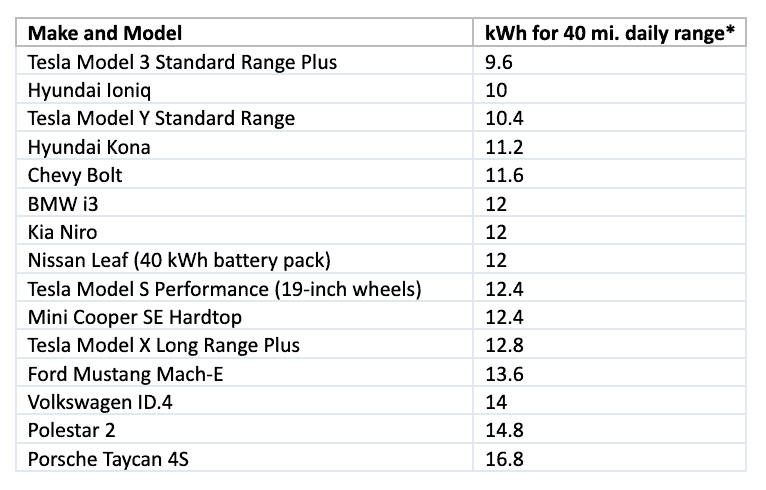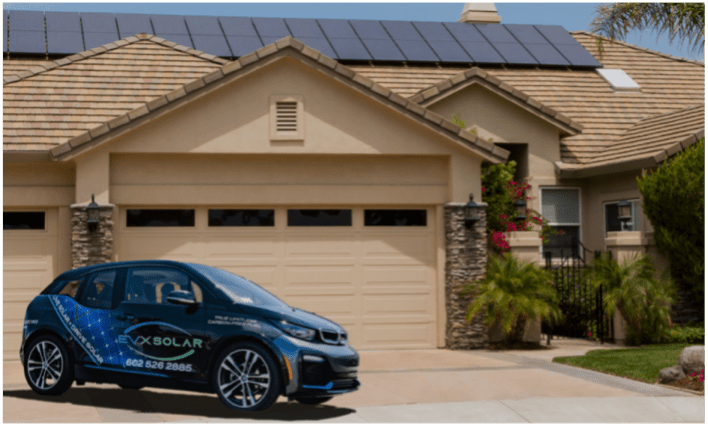Electric cars and solar panels are a perfect match.
There may not be a better pairing of technology than home solar panels and electric cars. Both offer a major shift away from how things have been done in the past, and together they spark a revolution in self-reliance, while leading to a better future for all.
First, let’s look at choosing an electric car. It is just smart driving. Even in the most expensive electricity markets, charging an EV is cheaper than buying gas for an internal combustion engine (ICE) car. EVs also have at least 25% lower maintenance costs compared to gas cars. And of course, EVs are better for the environment than burning fossil fuels. But how electric cars are powered makes a huge environmental difference. More EVs powered by the grid actually means more baseline energy requirement for the power utility. The true environmentally responsible way of powering an EV is with clean, sustainable residential solar.
Here’s a quick example:
According to the U.S. Department of Transportation, the average American drives about 13,500 miles per year, or about 40 miles per day. Over the course of a year, the driver of a gas-powered Hyundai Kona will pay around $1,877 for the 450 gallons of gasoline they’d need to go that far (based on 30 mpg fuel economy). And based on the April 2022 average gasoline price nationally.
If the driver chose a Kona EV instead, they’d need to buy 28 kWh of electricity for every 100 miles they drive. At the average electricity price of $0.1269/kWh in Arizona, they’d pay about $480.
But charging an EV from solar is even better. Here are some reasons:
- The cost of electricity from the grid power goes up every year, while solar panels keep producing electricity without additional cost
- Solar panels are far less polluting than electricity from the grid:
- 450 gallons of gas results in 8,820 lbs of CO2 emissions
- 3,780 kWh of grid power makes 1,531 lbs of CO2 (0.41 lbs/kWh + 35 lbs CO2 from EV lithium battery production)
- 3,780 kWh of home solar energy makes 368 lbs of CO2 (0.088 lbs/kWh + 35 lbs CO2 from EV battery)
Why you should charge your electric car with solar panels
There are many advantages to pairing solar panels with an EV. The best one is that it’s just cheaper. In nearly every state in the USA, including Arizona, the long-term cost of solar panels is less than buying electricity from the grid. In many cases, the cost of producing your own solar energy is more than 50% less than buying grid power.
If you have enough solar panels to meet your home’s energy needs and charge your car, you’ll save thousands of dollars over time. Plus, SunPower solar panels come with warranties to produce electricity for at least 25 years, so you’ll be saving long into the future.
Another huge benefit of solar is the environment. Switching to an EV means you’re cutting emissions by eliminating the need for gasoline and oil, but electricity from the grid still comes mostly from natural gas and coal. So solar reduces waste.
Just a handful of solar panels on your roof is enough to provide energy to charge your first EV, and your second, and more…for at least 25 years. It is incredible renewable energy.
How much does it cost to charge an electric car with solar and without?
When you drive an electric vehicle, every outlet supplies a way to get a few more miles into your car’s batteries. Realistically, though, you’ll probably want to find a level 2 EV charger for home use, or the equivalent of a Tesla supercharger if you’re traveling.
There are the basic three ways to charge your EV: the grid, public charging stations, or your own solar panels. Here’s how much each type costs:

Charging from the grid at home
The ongoing cost of fuel from the grid is whatever you currently pay for a kilowatt-hour (kWh). In the United States, that can be between about $.10 and $.40, but the average is about $.13/kWh. For every kWh in your battery, you’ll get about 3-4 miles of range, so about 12 kWh will get you a 40-mile round trip, at an average cost of $1.56.
That’s current information, but electricity prices rise every year, so next year, you might be paying 4 to 5% more, and over the lifetime of your car, prices will rise yearly. So, over the next 25 years, your average cost for a kWh of grid power will be around 17 cents if electricity prices rise just 2% per year — and we know that is most likely an underestimate.
Public charging stations
In real world situations, you may need to top up the “tank,” and using a public charging station to do so. In reality, this is pretty unavoidable if you own an EV, but you will save money if you can limit how often you must do it.
There are free EV charging stations, but for the most part, you’ll probably be paying for the electricity you need, and paying a lot, at that. Prices for charging vary by location. For example, Tesla charging stations currently cost $.28/kWh for Tesla owners. Services like Blink are even more costly, with a minimum charge of $.39/kWh, and a maximum of $.69/kWh for fast charging. Between Tesla and Blink, those charges are anywhere from 2 to 5 times more expensive than home charging from the grid.
Charging with home solar
If you pay for a solar panel system at your home, you’ll have to either lay out some cash or take a solar loan and pay over time. That’s not a small expense, but you can compare it to the cost of paying for electricity for the next 25 years.
To do that, you calculate something called the Levelized Cost of Energy, or LCOE, which is the total cost of installation spread over all the electricity your solar panels will generate in their lifetimes and adjusted for inflation.
The good news here is the LCOE of home solar in the U.S. is currently as low as $.07/kWh for systems with a current average solar installation cost of $3.00 per watt (as of January 2022) before the federal solar tax credit. In states with lots of sun, like Arizona, or states with additional incentives, like Massachusetts, solar LCOE is much lower.
Basically, by guaranteeing your fuel source (solar) for the next 25 years, you’ll save a huge amount of money on EV charging.
How to charge an EV with solar
Now that you know why you should charge an electric car with solar panels, here’s a little more about how to do it, to make sure you add the right number of panels and get a good value for the long term.
Here are the steps to use solar panels to charge your electric car:
Step 1: Determine how many kWh you need for your car for your driving habits
Step 2: Figure out how many solar panels you need to make those kWh
Step 3: Purchase solar equipment that can make that much electricity
Step 4: Get a Level 2 car charger
Step 5: Enjoy!
- Determine how many kWh you need every day
The first step is to find out how many kWh are needed to drive your car. If you keep track of mileage over a year, this step can be pretty easy. If not, you can estimate using an average number of miles per day.
According to the U.S. Department of Transportation, the average American drives about 13,500 miles per year, or about 40 miles per day. Let’s use that as a baseline. Here are the most efficient electric cars for 2022, excluding plug-in hybrid cars:
Top 15 U.S. electric vehicle models in 2022 by efficiency

*Sorted by kWh per 40 miles; data from FuelEconomy.gov; where multiple trim levels exist, the most efficient was chosen to limit each car model to one entry.
How many solar panels do you need to charge your electric car?
Based on the table above, you’ll need between around 10 and 17 kWh of electricity per day to charge an electric car. Let us help figure out how many solar panels you’ll need to make that much electricity.
We’ll look at the output of our SunPower solar panels and the amount of sun you get. A quick average we’ve found is that you’d need just over five panels to make enough energy to charge a Tesla Model 3 battery to get 40 miles of range. Using the same math, you can determine that you’ll need about seven 350-watt panels to charge a Nissan Leaf. And on it goes.
- Get the equipment needed to charge your electric car with solar
Of course, you can’t just stick five solar panels on your roof and plug them into your car. You’ll need a solar panel system and all the equipment that goes with it. And EVX Solar can help you get the best solution!
A typical solar and EV charging setup would include the following:
- Solar panels on your roof, mounted on metal racks and attached to the roof deck
- Inverters that convert the DC output of the solar panels to AC and to your main AC panel
- Level 2 EV charger
- Charge your EV
Once you have a solar array installed and you’ve added an EV, you’ll be able to plug it in, set the charging timer, and forget about it.
- Enjoy
Congratulations! You now have a solar-powered electric car and home. Most likely, you’ll be producing enough solar electricity to offset your car’s needs over the course of the year, reducing your carbon footprint, and saving money at the same time. And those same panels will produce enough electricity for your next car, and the one after that, too. 25 years of fuel, all on a small section of your roof!
The bottom line:
Making the switch from fossil fuels to solar electricity is good for your pocketbook, and also a great way to reduce your carbon footprint.
The amount of energy you’ll need depends on your car’s battery capacity and your average miles driven per day, but no matter how much electricity you need, you’ll probably save a lot of money by going solar for both your household needs and that car.
Key takeaways
- Electric cars are more efficient and less expensive than gas cars.
- Home solar is cheaper and less polluting than grid power over the long term in almost every place in the United States.
- Public EV charging is even more expensive than grid power and no less polluting.
- Charging an EV from home solar panels is better for the environment and your pocketbook.
- A home needs between 5 and 10 solar panels to charge an EV for 40 or more miles per one day of driving.
- The benefits of solar electricity are by far an investment worth looking into.
Let us help you with your solar energy and EV charging. Visit evxsolar.com



